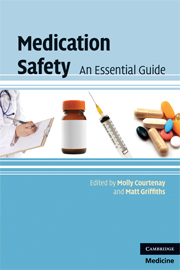Book contents
- Frontmatter
- Contents
- List of contributors
- Preface
- 1 Introduction to medication errors and medication safety
- 2 Safety in prescribing
- 3 Safety in dispensing
- 4 Safety in administering
- 5 Adverse drug reactions and drug interactions
- 6 Interface of care and communication
- 7 Parenteral drug administration
- 8 Calculations
- 9 Controlled drugs and patient safety
- 10 Reporting medication errors and near misses
- 11 Ensuring safety through evidence-based medicine
- Index
- References
7 - Parenteral drug administration
Published online by Cambridge University Press: 22 January 2010
- Frontmatter
- Contents
- List of contributors
- Preface
- 1 Introduction to medication errors and medication safety
- 2 Safety in prescribing
- 3 Safety in dispensing
- 4 Safety in administering
- 5 Adverse drug reactions and drug interactions
- 6 Interface of care and communication
- 7 Parenteral drug administration
- 8 Calculations
- 9 Controlled drugs and patient safety
- 10 Reporting medication errors and near misses
- 11 Ensuring safety through evidence-based medicine
- Index
- References
Summary
Introduction
Parenteral drug administration refers to drugs given by routes other than the digestive tract. The term parenteral is usually used for drugs given by injection or infusion. The enteral route usually refers to taking drugs by mouth. The common parenteral routes are listed in Table 7.1. In the USA the Food and Drug Administration (FDA) lists over 100 routes of drug administration (www.fda.gov/cder/dsm/).
Most hospital patients receive parenteral drugs at some time during their stay. Parenteral drug use is also increasingly common in the community setting (O'Hanlon, 2008). The intravenous (IV) route is associated with errors in several stages of the medication process (prescribing, preparing and administration) and this route has been associated with a higher number of errors than any other route (Hunt & Rapp, 1996; Cousins et al., 2005).
In one hospital ward study, there was at least one error made during preparation and administration in 212 (49%) out of 430 intravenous drug doses (Taxis & Barber, 2003). It is therefore important to only give drugs parenterally if it is not possible to use the simpler oral route – it is essential that the medication prescription is reviewed regularly and drug treatments changed to the safer oral route at the earliest opportunity.
- Type
- Chapter
- Information
- Medication SafetyAn Essential Guide, pp. 97 - 112Publisher: Cambridge University PressPrint publication year: 2009

